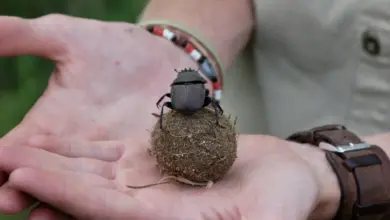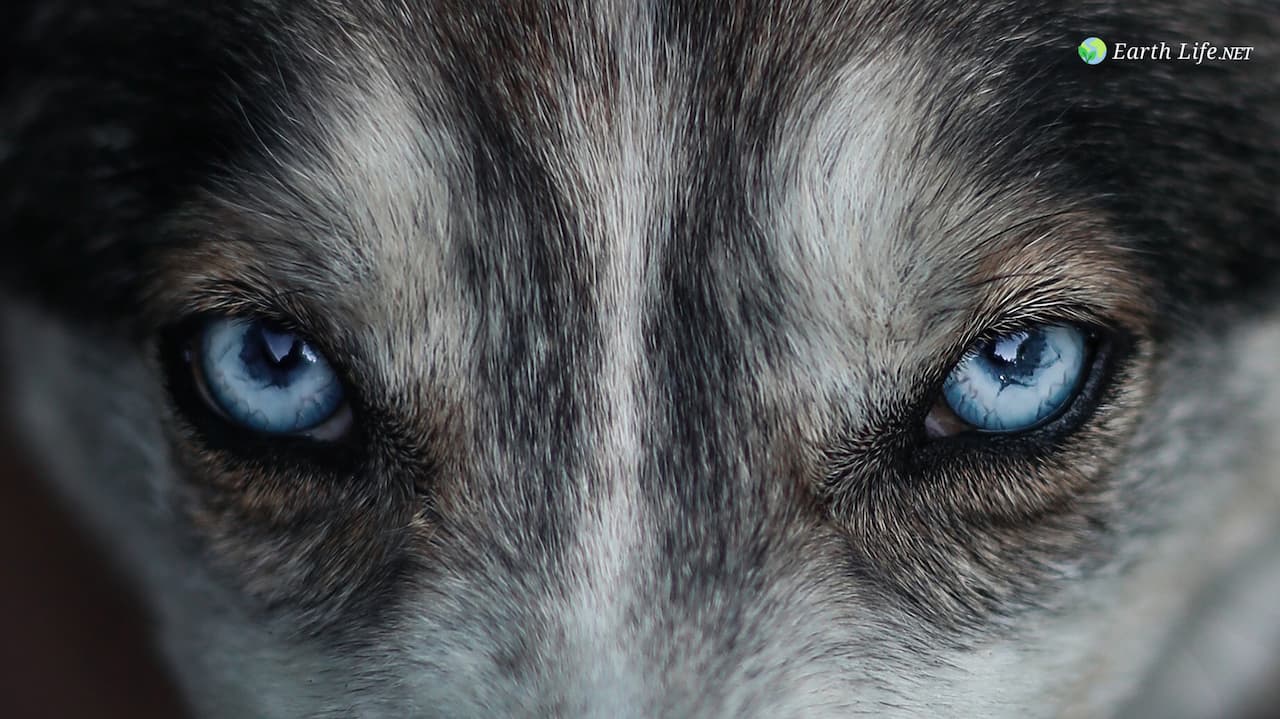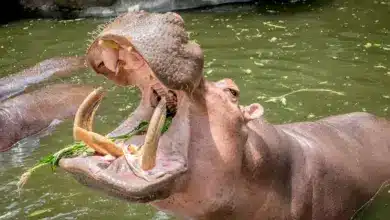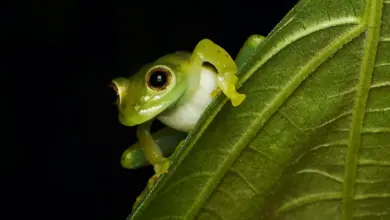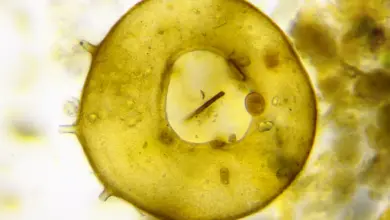14 Koala Predators: What Eats A Koala?
What Eats Koalas? What Do Koalas Eat?
Let’s look at what eats a Koala in the wild and why their numbers have dwindled to the point that they are endangered.
Koalas are mid-sized marsupials, a mammal with an opposable index finger that acts like the second thumb.
In fact, their differences from other marsupials are so marked that a separate family was carved out for them – they are called the “Phascolarctidae.”
In the presence of humans, Koalas are vulnerable to car accidents and death by domestic dogs.

However, in the wild, they are often preyed upon by dingoes, pythons, owls, crocodiles, and other large predators.
Until 2022, Koalas were classified as vulnerable, but in February 2022, their status changed to endangered. Let’s learn who such a cute animal is hunted by and why its numbers have dwindled to such an extent.
Koala Facts
Even though koalas are called koala bears, they aren’t bears. They are marsupials. And it’s no secret that they’re extremely cute mammals!
So let’s get to know a couple of facts about these adorable marsupials!
- Koalas have an 18-hour nap every day! Because they feed mostly on eucalyptus leaves that are low in nutrients, they sleep for longer hours to recover their energy.
- The term ‘Koala’ is said to mean ‘no drink’ in the Australian Aboriginal language. Since most of their water needs are fulfilled through the eucalyptus plant, they rarely need to drink water.
- These marsupials can eat up to two pounds of eucalyptus leaves in a day! But they’re picky eaters, so they feed on less than 50 of the 800 species of eucalyptus.
- Koalas are native to only Australia and found in eastern and southern Australia – Queensland, New South Wales, South Australia, and Victoria.
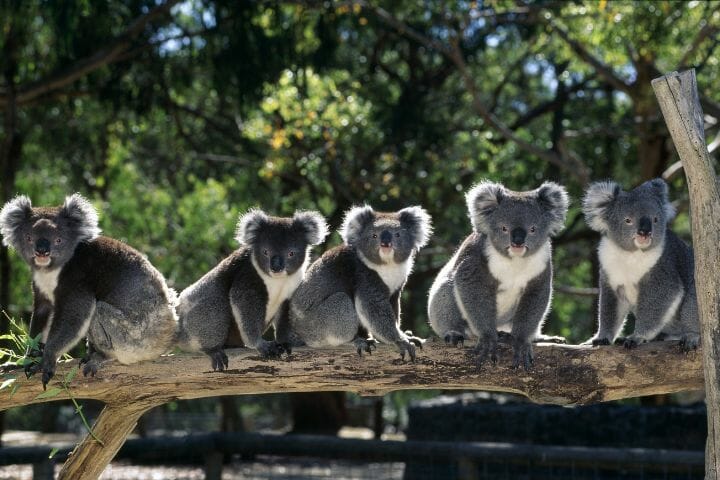
What Animals Eat Koalas?
Koala bears live on trees. They seldom climb down for anything. Unfortunately, their habitats are getting endangered day by day with increased deforestation and tree clearing.
This also makes them vulnerable to wild predators, adding to their already declining numbers. They find several predators on the ground, like snakes, dingoes, and owls. Let’s take a look.
Dingoes hunt Koalas
Dingoes are Australian wild dogs and apex predators that maintain systemic balance among the Australian wilds. They’re descended from Asian wolves and can grow to a height of more than 23 inches.
Dingoes are carnivores and the largest meat-eaters in the Australian continent. They feed on small to mid-sized native animals. Hence it’s no surprise that they are the Koala’s primary predators.

These animals hunt mainly during the night, alone or in packs, depending on how big or small their prey is. They are opportunistic eaters, so they hunt whatever they find, from feral to domestic animals.
Do domestic dogs hunt Koalas?
Koalas are vulnerable to serious injury or death by domestic dogs. These animals travel from tree to tree to find suitable food and shelter trees and set their home range.
In semi-urban areas, koalas may have to cross backyards while moving from one area to another. This would make them open to attacks by domestic dogs.

Younger koalas may need to travel further than adult koalas to find and establish their own home range. They get attacked by domestic dogs while doing this.
Even though koalas have sharp claws and jaws, a single dog bite can cause a life-threatening infection or significant internal damage.
Foxes eat Koalas
Australia is home to several species of foxes in the wild. In addition to attacking poultry and farms, they’re also a threat to the native koalas.
Mother koalas sometimes descend from trees to look for other habitats and shelters. This leaves baby koalas vulnerable to fox attacks.

There have been reports and research of foxes learning to climb trees in search of prey. This would invariably impact the native Australian tree dwellers, aka koala populations.
Wild dogs prey on koalas.
Wild dogs have been observed to contribute significantly to Australia’s declining koala population.
Research done between 2013-2017 on 503 koalas in the wild showed that of the 144 koala deaths, 81.3% could be attributed to wild dogs.
Additionally, 38 more deaths were suspected as a result of predation by wild dogs (even though these were unconfirmed reports).

Death by dog bites is the third most common cause of koala casualties following a reduction in habitat and car accidents in Australia.
Amethystine Python eats Koalas.
The amethystine Python is among the world’s longest snake species found in Australia. While it’s a non-venomous snake, it’s a carnivore and preys on animals for food.
It is a known predator of koalas. Both creatures live among branches of trees, i.e., are arboreal. Hence it’s natural for Python to feed on koalas.

These pythons wait camouflaged and ready for prey to pass them by and then strike when their poor prey has no inkling of it.
They are what are known as “sit-and-wait” predators. They kill their prey through constriction and subsequent suffocation.
Do white-lipped pythons eat koalas?
White-lipped pythons are native Australian snakes. These also happen to be one of the longest-found snakes in the world.
The females can grow up to more than 78 inches. They have distinct white bands near their mouths, which is probably how they got their names.

White-lipped pythons are non-venomous but carnivorous snakes. They feed on lizards, small-sized mammals, birds, and rodents. They’re known to be a significant predator of koalas in Australia.
The white-lipped Python kills its prey by coiling around the prey’s body and suffocating it before swallowing it.
Australian Barn Owls feed on Koalas.
The Australian barn owl is a significant predator of koalas on the continent. Barn owls are medium-sized birds with brown feathers and a white heart-shaped face.
These nocturnal creatures tend to feed on juvenile koala bears, among other terrestrial animals.
These carnivorous owls rely on their acute sense of hearing and sight to locate and hunt their prey, even in complete darkness.

They have the advantage of height to swoop down and hunt their prey once they locate it. The Australian barn owls primarily feed on small mammals but may also eat birds, frogs, and even some insects.
Powerful Owls hunt Koalas.
The largest owl on the Australian continent, powerful owls have a wingspan of 44-53 inches and an inland diving range of more than 124 miles.
Powerful owls prefer hunting arboreal mammals, especially marsupials, making them a top predator and threat to koalas.

While they rarely hunt adult koalas, the juveniles are majorly vulnerable to predation by powerful owls.
This apex predator of its narrow range glides from one branch to another, observing prey activity before swooping in to catch it. They generally eat their prey partially in small uneven parts.
Quolls eat koalas
Australia’s largest carnivorous marsupial, the Quoll, is yet another predator that can hunt koalas. There are four species of quolls in Australia, the spotted-tail Quoll being the largest.
As carnivorous animals, quolls feed on mammals and rodents of medium sizes, such as rats, possums, and koalas.

Quolls are tree climbers. This ability makes them a viable predator for the tree-dwelling koalas – they are able to stalk and hunt them from tree tops.
However, most times, quolls will only attack baby koalas or injured koalas and not healthy adults.
Do Crocodiles hunt Koalas?
Australia is home to Johnston’s crocodiles, also known as freshwater crocodiles.
They primarily reside in freshwater lakes and rivers in the tropical regions of Northern Australia. The females of this species can grow up to 7 feet long while males can be 8 feet.

Their diet consists of fish, lizards, insects, snakes, and small mammals. They can attack and hunt koalas for food if they find one walking on the ground.
Consecutively, the saltwater crocs of Australis prefer to feed on an injured koala or scavenge on a dead one.
Goannas hunt Koalas
Goannas, also known as monitor lizards, are a distinct species of big-sized lizards. Australia is home to around 27 different species of goannas, most of which are carnivorous.
Australian goannas can be identified by their distinct size. The largest species is the Perentie, which grows over 78 inches long. The shortest one is the Short-tailed monitor, which is just 8 inches long!

Goannas eat crocodile eggs, insects, birds, and small mammals like koalas. They have powerful claws and strong mandibles that they effectively use to hunt various prey.
Wedge-Tailed Eagles prey on Koalas.
The Wedge-Tailed Eagle is Australia’s largest raptor, with a wingspan of 6-7.5 feet. The diet of these carnivores consists of rabbits, feral cats, possums, koalas, and, less frequently, young emus, brown snakes, and goannas.
These arboreal creatures can be seen perched upon high branches, rocks, and cliffs, from where they can scan their surroundings effectively.

They mainly capture prey on the ground by gliding down on them and eating on the spot.
Koalas are more susceptible to attack by raptors than terrestrial animals and hence can be easily hunted by the white-tailed eagle.
White-bellied Sea Eagles eat Koalas.
White – Bellied Sea Eagles are primarily seen across Australia’s coastal areas.
While their diet primarily consists of aquatic life, such as fishes, sea snakes, and turtles, they may sometimes even hunt birds and terrestrial mammals.

The sea eagle has a wingspan of 6-7.2 ft and hunts by flying low over water or diving down at a 45-degree angle. Juvenile koalas in trees near water bodies can be vulnerable to predation by these sea eagles.
Additionally, during their movement from one tree to the next, adult koalas might get picked up by them.
Do Humans eat Koalas?
Humankind is, unfortunately, the biggest threat to most species in the animal kingdom. So it’s no surprise that they also cause potential danger to the vulnerable koala population.
The main cause behind why koala populations have reduced all over Australia is the loss of their habitat due to deforestation.

Secondly, when they are moving on the ground, cars run over koalas many times, and they end up as roadkill.
A few decades ago, koalas were even hunted for their soft fur.
Thankfully today, the wanton killing has stopped, and Koalas have come under the list of endangered species. Killing and hunting them is now illegal.
What Does A Koala Eat?
Koalas are herbivores. They like to feed the plant leaves that they spend most of their time in.
Their diet primarily consists of eucalyptus leaves. However, koalas are picky eaters and feed on less than 50 species of the available 800 species of eucalypt, as mentioned earlier.
They get most of their hydration from the water in the leaves and rarely climb down from the trees for water requirements.
Eucalyptus contains toxic compounds that koalas digest through a specialized digestive system and bacteria in their caecum.

Koalas are not born with this bacteria. Female koalas introduce it to baby koalas when they’re young through an excretion that the babies ingest.
There are a few other trees that Koalas sometimes might consider munching on. These are the box, bloodwood, and paperback trees.
Frequently Asked Questions
Why do dingoes eat koalas?
Koala populations in Australia are under a severe threat from dog attacks. They become susceptible to predation by dingoes when they climb down from the trees to change trees.
What is the food chain of the Koala?
Koalas are key to the food chain because they consume the excess vegetation of eucalyptus in forests and serve as prey for secondary consumers.
How many koalas are left?
The rapidly declining koala population is why they were enlisted as an endangered species in Eastern Australia.
What happens if a koala bites you?
If you get a koala bite, you might get a tissue infection likely associated with Lonepinella. It would require a combination treatment of antibiotics and surgical drainage.
Wrap-Up
Koalas are marsupials who live high up in the trees and feed on eucalyptus leaves. They’re native to the region of Australia and are now listed as an endangered species.
They have several natural predators in the wild, from dingoes to pythons and crocodiles. Their population is rapidly declining because of the loss of habitats, car accidents, and dog bite attacks.
Thank you for reading.


